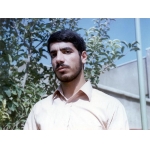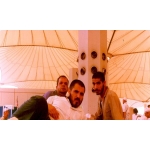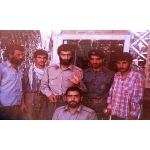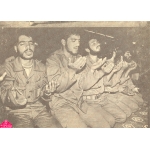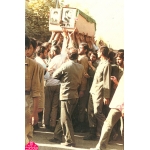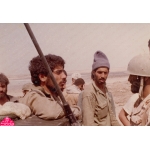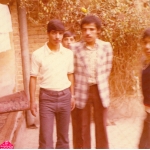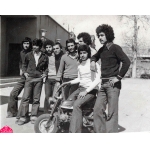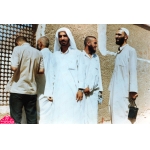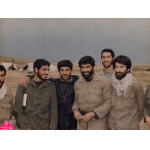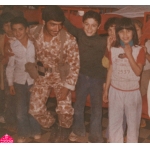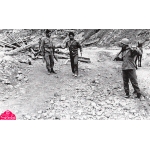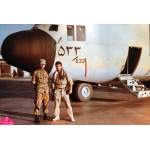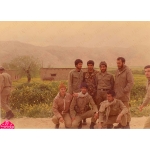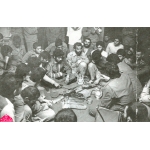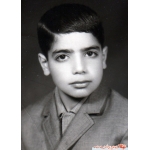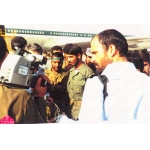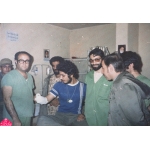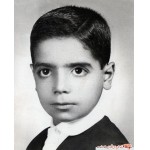Movahed Danesh, Alireza
Mohammad Hadi Fazaeli
249 بازدید
Alireza Movahed Danesh was the commander of the 10th Seyyed al-Shuhada (as) Brigade of the Islamic Revolutionary Guard Corps (IRGC) during the Iran-Iraq War.[1]
Alireza, the eldest child of the Movahed Danesh family, was born on September 18, 1958, in Tehran. His father, Haj Gholamhussain, worked in the defense industry. Alireza Movahed completed his primary education at Nobakht Islamic School.[2] After earning a diploma in electrical engineering from a technical school, he was admitted to the University of Tabriz in 1976. However, since his activities were watched by SAVAK, he withdrew from the university and joined the military in 1977. Following Imam Khomeini's call in 1978 for soldiers to desert the military bases, he fled his barracks and joined the revolutionary movement. Movahed Danesh played a role in the takeover of the Jamshidieh barracks and prevented General Nasiri's escape on February 11, 1979.[3]
On February 1, 1979, Movahed Danesh became a member of the security team of the committee for welcoming Imam Khomeini (ra). After the victory of the Islamic Revolution, he initially joined the Islamic Revolutionary Committee in Shemiran and joined the IRGC in April 1979. After serving three months guarding Imam Khomeini's residence, Movahed Danesh participated in the first training course at the Imam Hussain (as) Garrison in Tehran. [4] Then, he commanded a platoon in the Shuhada Battalion at Vali-e-Asr (as) Garrison in Tehran and was dispatched to protect the Bazargan border in the fall of 1979.[5] After returning to Tehran, he was assigned to guard the Evin Prison and later selected to provide security for the presidential office.
In late April 1980, with the intensification of anti-revolutionary activities, he was sent to Kurdistan as a platoon commander and participated in various operations. After clearing Sanandaj of anti-revolutionary forces, he returned to Tehran and was promoted to battalion commander. In the meantime, he was tasked with guarding several strategic locations, including the Khalij Barracks (central IRGC headquarters), the Parliament, and others. In his last mission before the onset of the Iran-Iraq War, Movahed Danesh was sent to Marivan in August 1980 and returned to Tehran in September.[6]
In June 1982, Movahed Danesh married Om-Salameh Molaei, the sister of Martyr Siros Molaei, with their marriage officiated by Imam Khomeini (ra).[7] Approximately nine months after his martyrdom, his only child, a daughter named Fatemeh, was born at Mostafa Khomeini Hospital in Tehran.[8]
At the outset of the war, Movahed Danesh and his battalion were deployed to Sarpol-e Zahab.[9] Shortly afterwards, he returned to Tehran on orders but, upon hearing of the siege of Khorramshahr, headed to Khuzestan.[10] After the fall of Khorramshahr, he returned to Tehran to assume responsibility for providing the security of the Vali-e-Asr (as) Garrison. He later joined the 9th Battalion under the command of Mohsen Vezvaei and returned to Sarpol-e Zahab.
On April 4, 1981, he led reconnaissance missions in the Korak Strait and assumed responsibility for the operation. Subsequently, he conducted a 20-day reconnaissance mission alongside Mohsen Vezvaei and Gholam-Ali Pichak in preparation for reclaiming the Bazi Deraz Heights. During the first and second phases of the operation Bazi Deraz carried out in May 1981, Movahed Danesh served as Vezvaei’s deputy and lost his right hand due to a sound grenade explosion.[11] In September 1981, when the third phase of the operation was underway, he performed hajj.[12]
On December 11, 1981, Movahed Danesh participated in Operation Matla al-Fajr, during which he was severely wounded in the Baraftab area of Sarpol-e Zahab, sustaining approximately 300 shrapnel injuries.[13] Before Operation Fath al-Mobin, he joined the 27th Muhammad Rasulullah (pbuh) Brigade and, after leading several reconnaissance missions, was appointed operational commander. On March 22, 1982, he became the commander of the Habib ibn Mazahir Battalion and participated in the operation.[14]
Movahed Danesh played a key role in planning and conducting reconnaissance missions for the four phases of Operation Beit al-Muqaddas. He actively participated in these operations in May and June 1982, during which he sustained a leg injury.[15] His brother, Muhammad Reza, was also martyred in the first phase of the operation.
Following Operation Beit al-Muqaddas and the Supreme Defense Council's decision in 1982 to counter Israeli aggression, Alireza Movahed Danesh was deployed to Lebanon as the commander of a battalion affiliated with the Muhammad Rasulullah (pbuh) Brigade.[16] Shortly afterwards, in preparation for Operation Ramadan, he handed over command of the battalion to his deputy, Salman Toroqi, and returned to Iran.
After the formation of the 10th Seyyed al-Shuhada (as) Brigade following Operation Ramadan, Alireza Movahed Danesh was appointed its commander in September 1982. His first mission was planning Operation Moslim ibn Aqil.[17] Due to disagreements over the execution of the operation, he stepped down from his position after its completion. Following his resignation, he joined the veteran forces under the command of the Veterans Headquarters and, by the order of Commander Akbar Nowjavan, joined the 10th Seyyed al-Shuhada (as) Brigade.
In 1983, he participated in Operation Valfajr, and in 1983 joined the Zuhair Battalion to participate in Operation Valfajr 1 during which he was injured in the head for the third time.[18] In his final deployment to the front lines, Movahed Danesh served as the commander of the 10th Seyyed al-Shuhada (as) Brigade and participated in Operation Valfajr 2 alongside the Ali-Asghar Battalion.[19]
On August 4, 1983, during operation Valfajr 2 in the Haj Omran region, Alireza Movahed Danesh was wounded in the leg by shrapnel from a mortar shell and martyred due to severe bleeding.[20] His body remained in the area for about a week, buried under the sand, until it was retrieved and buried on August 13, 1983, in Section 24 of Behesht Zahra Cemetery in Tehran.[21]
A street in the Aqdasiyeh neighborhood of Tehran has been named after the "Movahed Danesh Brothers" in their honor.[22] On December 4, 2019, during a ceremony at the National Congress of 92,000 Basij Martyrs, the Commander-in-Chief of the IRGC posthumously awarded the rank of Major General to Martyr Alireza Movahed Danesh.[23]
In addition to three books- Man o Ali o Jang (Me, Ali and the War), Movahed, and Yek Aseman Hayahou (A Sky Full of Clamor)—which have been written about him, parts of his life story are reflected in three other books namely Ostoreha (Legends)[24], Hampay Saeqe (Alongside the Thunder)[25], and Bikaraneha (The Infinite)[26]. Documentaries such as Zivaran-e Khelqat (The Adornments of Creation) directed by Hamed Hossaini (1993), Sakenan-e Haram Malakot (The Residents of the Heavenly Shrine) produced by Tehran Network’s Documentary Group (2002), and episode 24 of the Farmandehan (Commanders) documentary series directed by Ali Hamid (2010) depict some aspects of his personality. Furthermore, apart from two separate wills, one video interview and two audio recordings of him have been published to date.[27]
[1] Farhang-e Alam-e Shuhaday-e Tehran Bozorg (The Encyclopedia of Tehran’s Martyrs), Vol. 3, Tehran: Nashr-e Shahid, 1397, p. 2010.
[2] Esfandiari, Khalil, Ostorhah (Myths), Tehran: Shahid, 1380, p. 95.
[3] Mahnameh Farhangi Honari Sarv (Sarv Monthly), Year 6, Issue 53, Mordad 1402, p. 76.
[4] Esfandiari, Khalil, Astorhah (Myths), Pp. 95 and 96.
[5] Alavi-Zadeh, Soheila, Man o Ali o Jang (Me, Ali, and the War), Tehran: Sazman-e Joghrafyaie Niroohai-e Mosallah, 1382, Pp. 3 and 4.
[6] Ibid, Pp. 10-28.
[7] Defa Press, Issue 35653, 13 Mordad 1398; Payam Ashna, Issue 1669, 25 Mordad 1399, p. 8; Amiri, Muhammad, Movahed, Tehran: Taqdir, 1393, p. 81.
[8] Ibid, p. 116.
[9] Alavi-Zadeh, Soheila, Man o Ali o Jang (Me, Ali, and the War), p. 29.
[10] Ibid, p. 35.
[11] Ibid, Pp. 58-83.
[12] Ibid, Pp. 103-108.
[13] Ibid, Pp. 110 and 111.
[14] Esfandiari, Khalil, Ostorhah (Myths), p. 97.
[15] Alavi-Zadeh, Soheila, Man o Ali o Jang (Me, Ali, and the War), Pp. 122-138.
[16] Babaei, Gol-Ali, Behzad, Hussain, Hampay Saeqeh (Alongside the Thunder), Tehran: Soura Mehr, 4th Edition, 1387, p. 815.
[17] Alavi-Zadeh, Soheila, Man o Ali o Jang (Me, Ali, and the War), Pp. 141 and 142; Amiri, Muhammad, Movahed, Pp. 88 and 89.
[18] Ibid, Pp. 145-144; Ibid, Pp. 91-96.
[19] Ibid, Pp. 162 and 163; Ibid, Pp. 102 and 103.
[20] Kavandi, Ain-Allah, Bi-Karaneha (The Infinite), Zindeginameh Sardaran Shahid Sepah-e Ostane Tehran (Biography of Martyr Commanders of the Sepah in Tehran Province), Tehran: Kongereh-e Bozorgdasht-e Sardaran Shahid Sepah and 36,000 Shahid-e Tehran, 1376, p. 371.
[21] Esfandiari, Khalil, Ostoreha (Legends), p. 105.
[22] Iraniju.ir/aqdasiye-tehran
[23] Bashgah Khabarnegaran Javan, Issue 7160329, 13 Azar 1398.
[24] Esfandiari, Khalil, Ostoreha (Legends), p. 106.
[25] Babaei, Gol-Ali, Behzad, Hussain, Hampay Saeqeh (Alongside the Thunder), Pp. 808 and 819.
[26] Kavandi, Ain-Allah, Bi-Karaneha (The Infinite).
[27] Makhdoumi, Rahim, Yek Aseman Hiyaho (A Sky of Clamor): Based on the Life of Martyr Alireza Movahed Danesh, Tehran: Soura Mehr, 1385.



